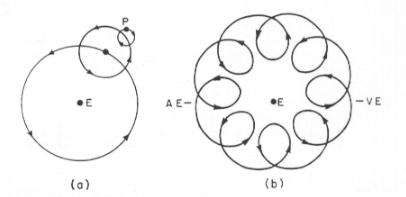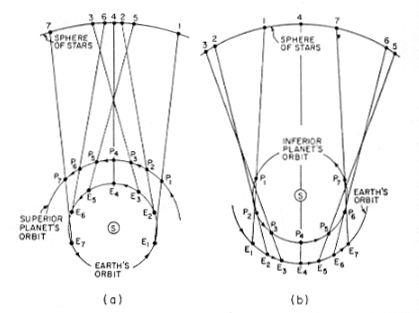

Discussion on De Revolutionibus.
Why does Copernicus think we should study astronomy? How does he appeal to his audience to accept his ideas? Does Copernicus seem particularly concerned with actual data? Notice that actual data is never mentioned. Why? What is Aristotelian perfect motion? What is this theory for? On Page 17 Copernicus explains how motion is a property of objects which are not in their proper places.
Hence the statement that the motion of a simple body is simple holds true in particular for circular motion, as long as the simple body abides in its natural place and with its whole. For when it is in place, it has none but circular motion, which remains wholly within itself like a body at rest. Rectilinear motion, however, affects things which leave their natural place or are thrust out of it or quit it in any manner whatsoever. Yet nothing is incompatible with the orderly arrangment of the unvierse and the design of the totality as someting out of place. Therefore rectilinear motion occurs only to things that are not in proper condition and are not in complete accord with their nature, when they are separated form their whole and forsake its unity.
Are we to believe the heavens are out of place?
Copernicus is offering a solution for theological, physical and aesthetic
reasons.
On Page 12 he presents an argument for the center of planetary orbit.
If we assume its daily rotation, another and no less important question follows concerning the earth's positon. To be sure, heretofore there has been virtually a unanimous acceptance of the belief that the middle of the universe is the earth. Anyone who denies that the earth occupies the middle or center of the universe may nevertheless assert that its distance [therefrom] is significant in comparison with [the distance of] the sphere of the fixed stars, but perceptible and noteworhty in relation to the spheres of the sun and the other planets. He may deem this to be the reason why their motions appear nonuniform, as conforming to a center other than the center of the earth. [Perhaps he can thereby] produce a not inept explanation of the apparent nonuniform motion. For the fact that the same planets are observed nearer to the earth and farther away proves that the center of the earth is not the center of their circles. It is less clear whether the approach and withdrawal are executed by the earth or the other planets.Here, Copernicus presents Aristotle's argument about natural motion, on page 14.
In like manner, the ancient philosophers analyze motion and its nature in a further attempt to confirm their conclusion. Thus, according to Aristotle, the motion of a single simple body is simple; of the simple motions, one is straight, and the other is circular; of the straight motions, one is upward and the other is downward. Hence every simple motion is either toward the middle, that is downward; or away from the middle, that is, upward; or around the middle, that is, circular. To be carried downward, that is the property of earth and water, which are considered heavy; on the other hand, air and fire, which are endowed with lightness, move upward and away form the middle. To these four elements it seems reasonable to assign rectilinear motion, but to the heavenly bodies, circular mtion around the middle.
Review of retrograde motion in the Ptolemaic context.
P.69, Figure 23

Do you think it is easier to compute where retrograde motion happens, or is it easier to visualize retrograde motion. Is it easier to visualize in Copernican or Ptolemaic system? Take vote.
On page 13 Copernicus discusses how stars are so far away that lines become parallel.
P.166, Figure 32

Yet a line drawn from the earth's surface [to a point in the firmament] must be distinct from the line drawn form the earth's center to the [same point]. Nevertheless, because these lines are immense in relation to the earth, they become parallel lines [III, 15]. Because their terminus is enormously remote they appear to be a single line. For in comparison with Their length the space enclosed by them becomes imperceptible, as is demonstrated in optics.
Class divides into groups of 2 or 3. Each group takes large pieces of paper, and colored string for a compass.
a. Describe where the planets are in relation to earth and sun during retrograde motion.
b. How many such relative positions can you find find?
c. If distances are as in your picture, how frequently should one see retrograde motion?
d. For the purposes of describing retrograde motion qualitatively, which is simpler, the Ptolemaic model or the Copernican model? Why?
e. Which is more satisfying? Why?